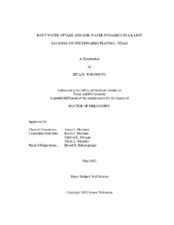| dc.description.abstract | Woody plants are encroaching into a karst savanna on the Edwards Plateau in central Texas, but their impact on hydrology is unclear because of high variability in soil depth and uncertainties about shallow and deep root contributions to water uptake, and water dynamics in rocky soil. The overall objectives of this study are to quantify contributions of shallow and deep roots to water uptake, and to quantify the impact of rock on soil hydraulic properties and water storage. A study was conducted in a karst savanna with ~50% woody cover to monitor spatial and temporal variations in soil moisture and root water uptake with neutron probe and time-domain reflectometry measurements. Bulk density was measured using gamma densitometry. Measurements were made to a depth of 1.6 m in a 25 m 25 m grid (5 m node spacing). The results showed that rock created high spatial variability in water storage. Water storage capacity in the measurement grid ranged from 185 to 401 mm, and coupled with heterogeneous distribution of trees led to high spatial variability in root water uptake. Most of the water uptake came from the upper 1 m of the soil profile, but 10% came from below 1.6 m. This indicated that roots had access to water stored within the bedrock, possibly in soil pockets. Statistical analysis showed that spatial distribution of θ was significantly correlated with rock distribution in the profile. Laboratory evaporation measurements showed that Small volume fractions of rock can increase evaporation from soils by slowing upward movement of water, thereby maintaining capillary connectivity to the surface for a longer period of time. Two simulation models, van Genuchten (VG) and Durner, were compared with the data from evaporation experiments. Results showed that the Durner model was more appropriate than the VG model for describing water retention and hydraulic conductivity of rocky soils. | en |


